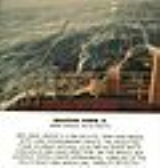
Spindrift
Encyclopedia

Gale
A gale is a very strong wind. There are conflicting definitions of how strong a wind must be to be considered a gale. The U.S. government's National Weather Service defines a gale as 34–47 knots of sustained surface winds. Forecasters typically issue gale warnings when winds of this strength are...
. This spray, which "drifts" in the direction of the gale, is one of the characteristics of a wind speed of 8 Beaufort
Beaufort scale
The Beaufort Scale is an empirical measure that relates wind speed to observed conditions at sea or on land. Its full name is the Beaufort Wind Force Scale.-History:...
and higher at sea.
In Great Britain "spindrift" is the telltale sign used by mariners to define a Force 8 (Beaufort Scale) wind (not higher) when observed at sea. See this example of information provided by Lymington Harbour authority, Hampshire, England, UK, explaining the whole scale, the associated wind speeds, and its telltale signs:
http://www.lymingtonharbour.co.uk/Information/Frameset.html
Text from the site states:
Force 8, defined as "Gale". Wind speed 39-46 mph, equal to 34-40 knots. Inland, twigs break off trees; progress generally impeded. At sea, moderately high waves of greater length; edges of crests begin to break into spindrift; foam is blown in well-marked streaks along the direction of the wind.
Relatedly, spindrift can also be used to describe fine sand or snow that is blown off by the wind.
Spindrift is a southern English word, Spoondrift a northern or Scottish word. The Scottish word spoondrift can be used to describe fine snow that is blown off the hills by the wind.
Some sources regard "spoondrift" as a direct alternative to "spindrift" in all its uses. For example, see http://www.crosswordsolver.org/definition/S/spoondrift.

